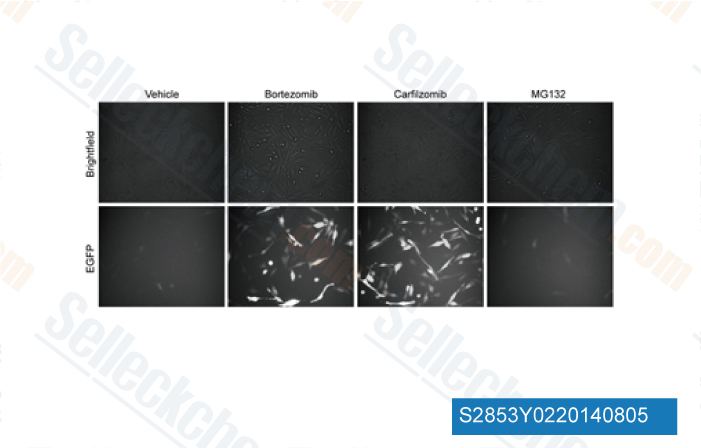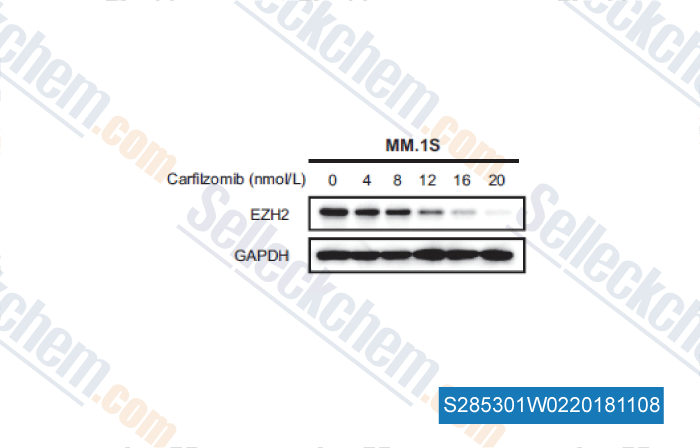|
Toll Free: (877) 796-6397 -- USA and Canada only -- |
Fax: +1-832-582-8590 Orders: +1-832-582-8158 |
Tech Support: +1-832-582-8158 Ext:3 Please provide your Order Number in the email. |
Technical Data
| Formula | C40H57N5O7 |
|||
| Molecular Weight | 719.91 | CAS No. | 868540-17-4 | |
| Solubility (25°C)* | In vitro | DMSO | 100 mg/mL (138.9 mM) | |
| Water | Insoluble | |||
| Ethanol | Insoluble | |||
|
* <1 mg/ml means slightly soluble or insoluble. * Please note that Selleck tests the solubility of all compounds in-house, and the actual solubility may differ slightly from published values. This is normal and is due to slight batch-to-batch variations. * Room temperature shipping (Stability testing shows this product can be shipped without any cooling measures.) |
||||
Preparing Stock Solutions
Biological Activity
| Description | Carfilzomib (PR-171) is an irreversible proteasome inhibitor with IC50 of <5 nM in ANBL-6 cells, displayed preferential in vitro inhibitory potency against the ChT-L activity in the β5 subunit, but little or no effect on the PGPH and T-L activities. Carfilzomib activates prosurvival autophagy and induces cell apoptosis. | ||
|---|---|---|---|
| Targets |
|
||
| In vitro | Carfilzomib inhibits proliferation in a variety of cell lines and patient-derived neoplastic cells, including multiple myeloma, and induced intrinsic and extrinsic apoptotic signaling pathways and activation of c-Jun-N-terminal kinase (JNK). Carfilzomib reveals enhanced anti-MM activity compared with bortezomib, overcome resistance to bortezomib and other agents, and acts synergistically with dexamethasone (Dex). Carfilzomib shoes preferential in vitro inhibitory potency against the ChT-L activity in the β5 subunit, with over 80% inhibition at doses of 10 nM. Short exposure to low-dose Carfilzomib leads to preferential binding specificity for the β5 constitutive 20S proteasome and the β5i immunoproteasome subunits. Measurement of caspase activity in ANBL-6 cells pulsed with Carfilzomib reveals substantial increases in caspase-8, caspase-9, and caspase-3 activity after 8 hours, giving a 3.2-, 3.9- and 6.9-fold increase, respectively, over control cells after 8 hours. In carfilzomib pulse-treated cells, the mitochondrial membrane integrity is decreased to 41% (Q1 + Q2), compared with 75% in vehicle-treated control cells. [1] In another study, Carfilzomib has also shown preclinical effectiveness against hematological and solid malignancies. [2] Carfilzomib directly inhibits osteoclasts formation and bone resorption. [3] |
||
| In vivo | Carfilzomib moderately reduces tumor growth in an in vivo xenograft model. Carfilzomib effectively decreases multiple myeloma cell viability following continual or transient treatment mimicking. Carfilzomib increases trabecular bone volume, decreases bone resorption and enhances bone formation in non-tumor bearing mice. [3] |
Protocol (from reference)
| Kinase Assay: |
|
|---|---|
| Cell Assay: |
|
| Animal Study: |
|
References
Customer Product Validation

-
Data from [Data independently produced by Sci Transl Med, 2014, 6(250), 250ra112]

-
Data from [Cancer Res, 2014, 74(16), 4458-69]

-
Data from [J Virol, 2013, 87(23), 13035-41]

-
Data from [Data independently produced by , , Clin Cancer Res, 2017, 23(16):4817-4830]
Selleck's Carfilzomib (PR-171) has been cited by 226 publications
| A structure-based designed small molecule depletes hRpn13Pru and a select group of KEN box proteins [ Nat Commun, 2024, 15(1):2485] | PubMed: 38509117 |
| MUC20 regulated by extrachromosomal circular DNA attenuates proteasome inhibitor resistance of multiple myeloma by modulating cuproptosis [ J Exp Clin Cancer Res, 2024, 43(1):68] | PubMed: 38439082 |
| Targeting of mitochondrial fission through natural flavanones elicits anti-myeloma activity [ J Transl Med, 2024, 22(1):208] | PubMed: 38413989 |
| A small-molecule degrader selectively inhibits the growth of ALK-rearranged lung cancer with ceritinib resistance [ iScience, 2024, 27(2):109015.] | PubMed: 38327793 |
| GZ17-6.02 interacts with proteasome inhibitors to kill multiple myeloma cells [ Oncotarget, 2024, 15:159-174] | PubMed: 38441437 |
| Large-scale RNA-seq mining reveals ciclopirox triggers TDP-43 cryptic exons [ bioRxiv, 2024, 2024.03.27.587011] | PubMed: 38585725 |
| BRD4-targeting PROTAC as a unique tool to study biomolecular condensates [ Cell Discov, 2023, 9(1):47] | PubMed: 37156794 |
| Combinations of ivermectin with proteasome inhibitors induce synergistic lethality in multiple myeloma [ Cancer Lett, 2023, 565:216218] | PubMed: 37149018 |
| Mutations in the B30.2 and the central helical scaffold domains of pyrin differentially affect inflammasome activation [ Cell Death Dis, 2023, 14(3):213] | PubMed: 36966139 |
| Dual inhibition of thioredoxin reductase and proteasome is required for auranofin-induced paraptosis in breast cancer cells [ Cell Death Dis, 2023, 14(1):42] | PubMed: 36658130 |
RETURN POLICY
Selleck Chemical’s Unconditional Return Policy ensures a smooth online shopping experience for our customers. If you are in any way unsatisfied with your purchase, you may return any item(s) within 7 days of receiving it. In the event of product quality issues, either protocol related or product related problems, you may return any item(s) within 365 days from the original purchase date. Please follow the instructions below when returning products.
SHIPPING AND STORAGE
Selleck products are transported at room temperature. If you receive the product at room temperature, please rest assured, the Selleck Quality Inspection Department has conducted experiments to verify that the normal temperature placement of one month will not affect the biological activity of powder products. After collecting, please store the product according to the requirements described in the datasheet. Most Selleck products are stable under the recommended conditions.
NOT FOR HUMAN, VETERINARY DIAGNOSTIC OR THERAPEUTIC USE.
